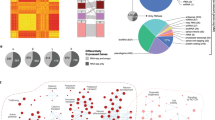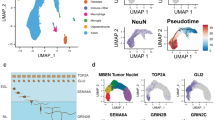Abstract
To increase our understanding of the molecular pathogenesis of medulloblastoma (MB), we utilized the technique of suppression subtractive hybridization (SSH) to identify genes that are dysregulated in MB when compared to cerebellum. SSH-enriched cDNA libraries from both human and Ptch+/− heterozygous murine MBs were generated by subtracting common cDNAs from corresponding non-neoplastic cerebellum. For the human classic MB library, total human cerebellar RNA was used as control tissue; for the Ptch+/− heterozygous MB, non-neoplastic cerebellum from an unaffected Ptch+/− littermate was used as the control. Through differential screening of these libraries, over 100 upregulated tumor cDNA fragments were isolated, sequenced and identified with the NCBI BLAST program. From these, we selected genes involved in cellular proliferation, antiapoptosis, and cerebellar differentiation for further analysis. Upregulated genes identified in the human MB library included Unc33-like protein (ULIP), SOX4, Neuronatin (NNAT), the mammalian homologue of Drosophila BarH-like 1(BARHL1), the nuclear matix protein NRP/B (ENC1), and the homeobox OTX2 gene. Genes found to be upregulated in the murine MB library included cyclin D2 (Ccnd2), thymopoietin (Tmpo), Musashi-1 (Msh1), protein phosphatase 2A inhibitor-2 (I-2pp2a), and Unc5h4(D). Using semiquantitative reverse transcription–polymerase chain reaction (RT–PCR), the mRNA expression levels for these genes were markedly higher in human MBs than in cerebellum. Western blot analysis was used to further confirm the overexpression of a subset of these genes at the protein level. Notch pathway overactivity was demonstrated in the TE671 MB cell line expressing high levels of MSH1 through HES1-Luciferase transfections. This study has revealed a panel of developmentally regulated genes that may be involved in the pathogenesis of MB.
This is a preview of subscription content, access via your institution
Access options
Subscribe to this journal
Receive 50 print issues and online access
We are sorry, but there is no personal subscription option available for your country.
Buy this article
- Purchase on SpringerLink
- Instant access to full article PDF
Prices may be subject to local taxes which are calculated during checkout




Similar content being viewed by others
Accession codes
References
Artavanis-Tsakonas S, Rand MD and Lake RJ . (1999). Science, 284, 770–776.
Bayani J, Zielenska M, Marrano P, Kwan Ng Y, Taylor MD, Jay V, Rutka JT and Squire JA . (2000). J. Neurosurg., 93, 437–448.
Boncinelli E, Gulisano M and Broccoli V . (1993). J. Neurobiol., 24, 1356–1366.
Buhren J, Christoph AH, Buslei R, Albrecht S, Wiestler OD and Pietsch T . (2000). J. Neuropathol. Exp. Neurol., 59, 229–240.
Bulfone A, Menguzzato E, Broccoli V, Marchitiello A, Gattuso C, Mariani M, Consalez GG, Martinez S, Ballabio A and Banfi S . (2000). Hum. Mol. Genet., 9, 1443–1452.
Byk T, Dobransky T, Cifuentes-Diaz C and Sobel A . (1996). J. Neurosci., 16, 688–701.
Chee M, Yang R, Hubbell E, Berno A, Huang XC, Stern D, Winkler J, Lockhart DJ, Morris MS and Fodor SP . (1996). Science, 274, 610–614.
Cheung M, Abu-Elmagd M, Clevers H and Scotting PJ . (2000). Brain Res. Mol. Brain Res., 79, 180–191.
Chu S, DeRisi J, Eisen M, Mulholland J, Botstein D, Brown PO and Herskowitz I . (1998). Science, 282, 699–705.
Diatchenko L, Lau YF, Campbell AP, Chenchik A, Moqadam F, Huang B, Lukyanov S, Lukyanov K, Gurskaya N, Sverdlov ED and Siebert PD . (1996). Proc. Natl. Acad. Sci., USA, 93, 6025–6030.
Duman-Scheel M, Weng L, Xin S and Du W . (2002). Nature, 417, 299–304.
Frantz GD, Weimann JM, Levin ME and McConnell SK . (1994). J. Neurosci., 14, 5725–5740.
Goodrich LV, Milenkovic L, Higgins KM and Scott MP . (1997). Science, 277, 1109–1113.
Goshima Y, Nakamura F, Strittmatter P and Strittmatter SM . (1995). Nature, 376, 509–514.
Hong K, Hinck L, Nishiyama M, Poo MM, Tessier-Lavigne M and Stein E . (1999). Cell, 97, 927–941.
Huard JM, Forster CC, Carter ML, Sicinski P and Ross ME . (1999). Development, 126, 1927–1935.
Imai T, Tokunaga A, Yoshida T, Hashimoto M, Mikoshiba K, Weinmaster G, Nakafuku M and Okano H . (2001). Mol. Cell Biol., 21, 3888–3900.
Ji W, Wright MB, Cai L, Flament A and Lindpaintner K . (2002). BMC Genom., 3, 12.
Kanemura Y, Mori K, Sakakibara S, Fujikawa H, Hayashi H, Nakano A, Matsumoto T, Tamura K, Imai T, Ohnishi T, Fushiki S, Nakamura Y, Yamasaki M, Okano H and Arita N . (2001). Differentiation, 68, 141–152.
Kozmik Z, Sure U, Ruedi D, Busslinger M and Aguzzi A . (1995). Proc. Natl. Acad. Sci. USA, 92, 5709–5713.
Laudet V, Stehelin D and Clevers H . (1993). Nucleic Acids Res., 21, 2493–2501.
Lee CJ, Appleby VJ, Orme AT, Chan WI and Scotting PJ . (2002). J. Neurooncol., 57, 201–214.
Leonardo ED, Hinck L, Masu M, Keino-Masu K, Ackerman SL and Tessier-Lavigne M . (1997). Nature, 386, 833–838.
Li W, Herman RK and Shaw JE . (1992). Genetics, 132, 675–689.
Liang P and Pardee AB . (1992). Science, 257, 967–971.
Llambi F, Causeret F, Bloch-Gallego E and Mehlen P . (2001). EMBO J., 20, 2715–2722.
McGill MA and McGlade CJ . (2003). J. Biol. Chem., 278, 23196–23203.
Michiels EM, Oussoren E, Van Groenigen M, Pauws E, Bossuyt PM, Voute PA and Baas F . (1999). Physiol. Genom., 1, 83–91.
Okano H, Imai T and Okabe M . (2002). J. Cell Sci., 115, 1355–1359.
Pomeroy SL, Tamayo P, Gaasenbeek M, Sturla LM, Angelo M, McLaughlin ME, Kim JY, Goumnerova LC, Black PM, Lau C, Allen JC, Zagzag D, Olson JM, Curran T, Wetmore C, Biegel JA, Poggio T, Mukherjee S, Rifkin R, Califano A, Stolovitzky G, Louis DN, Mesirov JP, Lander ES and Golub TR . (2002). Nature, 415, 436–442.
Ross ME, Carter ML and Lee JH . (1996). J. Neurosci., 16, 210–219.
Rostomily RC, Bermingham-McDonogh O, Berger MS, Tapscott SJ, Reh TA and Olson JM . (1997). Cancer Res., 57, 3526–3531.
Rubin JB and Rowitch DH . (2002). Cancer Cell, 2, 7–8.
Saito T, Sawamoto K, Okano H, Anderson DJ and Mikoshiba K . (1998). Dev. Biol., 199, 216–225.
Sambrook J, Fritsch E and Maniatis T . (1989). Molecular Cloning, 2nd edn. Cold Springs Harbor Laboratory Press: Cold Springs Harbor.
Simeone A, Acampora D, Gulisano M, Stornaiuolo A and Boncinelli E . (1992). Nature, 358, 687–690.
Solecki DJ, Liu XL, Tomoda T, Fang Y and Hatten ME . (2001). Neuron, 31, 557–568.
Taylor MD, Mainprize TG and Rutka JT . (2000). Neurosurgery, 47, 888–901.
van de Wetering M, Oosterwegel M, van Norren K and Clevers H . (1993). EMBO J., 12, 3847–3854.
Velculescu VE, Zhang L, Zhou W, Vogelstein J, Basrai MA, Bassett Jr DE, Hieter P, Vogelstein B and Kinzler KW . (1997). Cell, 88, 243–251.
Vincent S, Turque N, Plaza S, Dhellemmes P, Hladky JP, Assaker R, Ruchoux MM and Saule S . (1996). Int. J. Cancer, 8, 901.
Wakamatsu Y, Maynard TM, Jones SU and Weston JA . (1999). Neuron, 23, 71–81.
Wang LH and Strittmatter SM . (1996). J. Neurosci., 16, 6197–6207.
Wechsler-Reya R and Scott MP . (2001). Annu. Rev. Neurosci., 24, 385–428.
Weinberg RA . (1995). Cell, 81, 323–330.
Wetmore C, Eberhart DE and Curran T . (2001). Cancer Res., 61, 513–516.
Yokota N, Aruga J, Takai S, Yamada K, Hamazaki M, Iwase T, Sugimura H and Mikoshiba K . (1996). Cancer Res., 56, 377–383.
Yokota N, Nishizawa S, Ohta S, Date H, Sugimura H, Namba H and Maekawa M . (2002). Int. J. Cancer, 101, 198–201.
Yokota N, Uchijima M, Nishizawa S, Namba H and Koide Y . (2001). Stroke, 32, 168–174.
Yoon JW, Kita Y, Frank DJ, Majewski RR, Konicek BA, Nobrega MA, Jacob H, Walterhouse D and Iannaccone P . (2002). J. Biol. Chem., 277, 5548–5555.
Acknowledgements
This study was supported in part by grants from the National Cancer Institute of Canada, the Pediatric Brain Tumor Foundation of the United States, the Ontario Cancer Research Network and the Neurosurgical Research and Educational Foundation. Dr Rutka is a Scientist of the Canadian Institutes of Health Research. Dr Yokota was partially supported by a grant from the Japanese Ministry of Education, Culture, Sports, Science and Technology (No 13671430).
Author information
Authors and Affiliations
Corresponding author
Rights and permissions
About this article
Cite this article
Yokota, N., Mainprize, T., Taylor, M. et al. Identification of differentially expressed and developmentally regulated genes in medulloblastoma using suppression subtraction hybridization. Oncogene 23, 3444–3453 (2004). https://doi.org/10.1038/sj.onc.1207475
Received:
Revised:
Accepted:
Published:
Issue Date:
DOI: https://doi.org/10.1038/sj.onc.1207475



